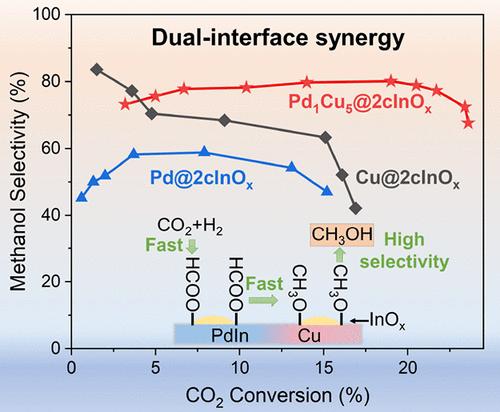利用氧化物/金属双界面打破二氧化碳合成甲醇过程中的转化率与选择性权衡
IF 14.4
1区 化学
Q1 CHEMISTRY, MULTIDISCIPLINARY
引用次数: 0
摘要
利用从可再生资源中提取的绿色氢气,将二氧化碳(CO2)选择性加氢转化为甲醇等高附加值化学品,是实现二氧化碳减排和碳资源利用的一种前景广阔的方法。然而,这一过程存在反向水气变换(RWGS)和甲醇分解的竞争性副反应,这往往会导致转换选择性失衡,从而导致甲醇收率低下。在此,我们报告了在 PdCu 双金属纳米粒子(NPs)上包覆 InOx 以构建亲密的 InOx/Cu 和 InOx/PdIn 双界面,从而打破了转化率-选择性权衡,在二氧化碳转化率接近热力学极限的 20% 的条件下实现了 ∼ 80% 的甲醇选择性,远远优于具有单一活性金属/氧化物界面的传统金属催化剂。全面的显微和光谱表征显示,InOx/PdIn 界面有利于将二氧化碳活化为甲酸盐,而相邻的 InOx/Cu 界面则容易将甲酸盐中间体转化为甲氧基物种,从而协同促进甲醇的生产。这些通过双金属 NP 的氧化物涂层实现双界面协同作用的发现,为设计用于先进催化的活性和选择性催化剂开辟了一条新途径。本文章由计算机程序翻译,如有差异,请以英文原文为准。

Breaking the Conversion-Selectivity Trade-Off in Methanol Synthesis from CO2 Using Dual Intimate Oxide/Metal Interfaces
The selective hydrogenation of carbon dioxide (CO2) to value-added chemicals, e.g., methanol, using green hydrogen retrieved from renewable resources is a promising approach for CO2 emission reduction and carbon resource utilization. However, this process suffers from the competing side reaction of reverse water–gas shift (RWGS) and methanol decomposition, which often leads to a strong conversion-selectivity trade-off and thus a poor methanol yield. Here, we report that InOx coating of PdCu bimetallic nanoparticles (NPs) to construct intimate InOx/Cu and InOx/PdIn dual interfaces enables the break of conversion-selectivity trade-off by achieving ∼80% methanol selectivity at ∼20% CO2 conversion close to the thermodynamic limit, far superior to that of conventional metal catalysts with a single active metal/oxide interface. Comprehensive microscopic and spectroscopic characterization revealed that the InOx/PdIn interface favors the activation of CO2 to formate, while the adjacent InOx/Cu interface readily converts formate intermediates to methoxy species in tandem, which thus cooperatively boosts methanol production. These findings of dual-interface synergies via oxide coating of bimetallic NPs open a new avenue to the design of active and selective catalysts for advanced catalysis.
求助全文
通过发布文献求助,成功后即可免费获取论文全文。
去求助
来源期刊
CiteScore
24.40
自引率
6.00%
发文量
2398
审稿时长
1.6 months
期刊介绍:
The flagship journal of the American Chemical Society, known as the Journal of the American Chemical Society (JACS), has been a prestigious publication since its establishment in 1879. It holds a preeminent position in the field of chemistry and related interdisciplinary sciences. JACS is committed to disseminating cutting-edge research papers, covering a wide range of topics, and encompasses approximately 19,000 pages of Articles, Communications, and Perspectives annually. With a weekly publication frequency, JACS plays a vital role in advancing the field of chemistry by providing essential research.

 求助内容:
求助内容: 应助结果提醒方式:
应助结果提醒方式:


